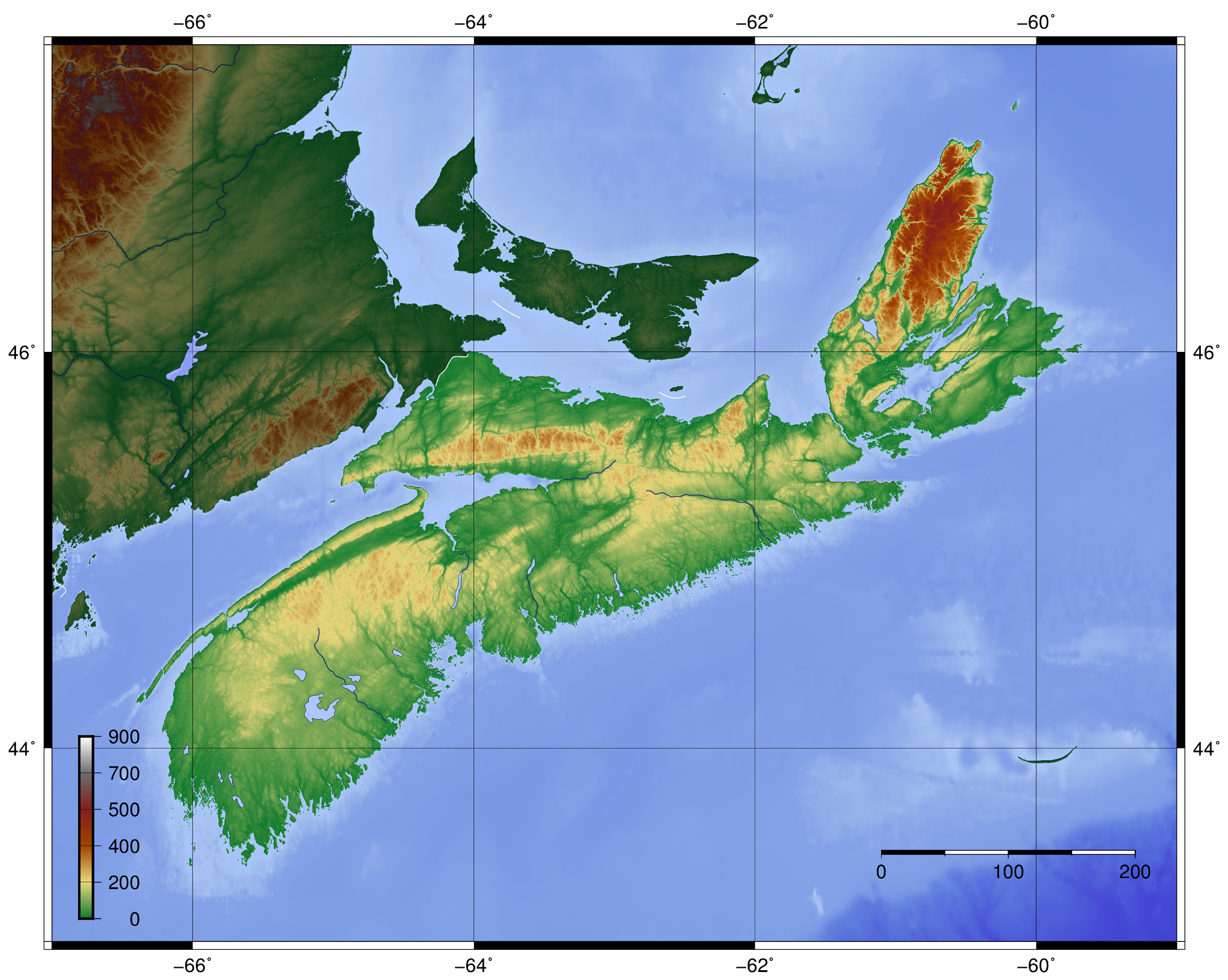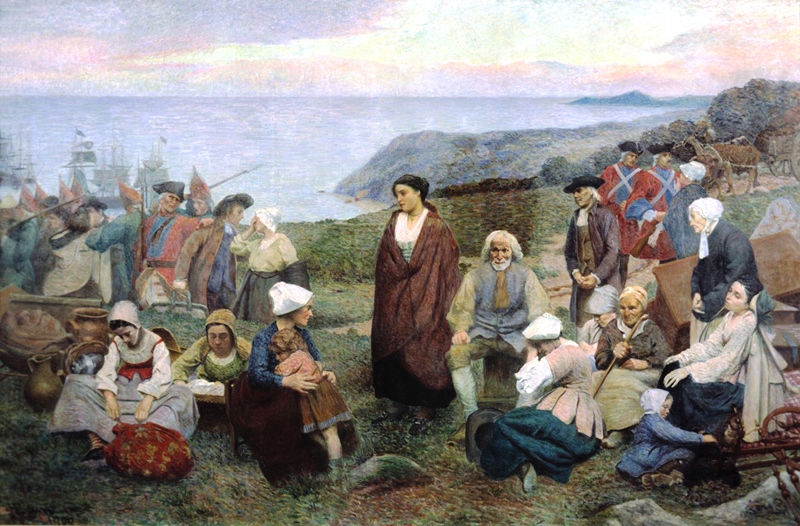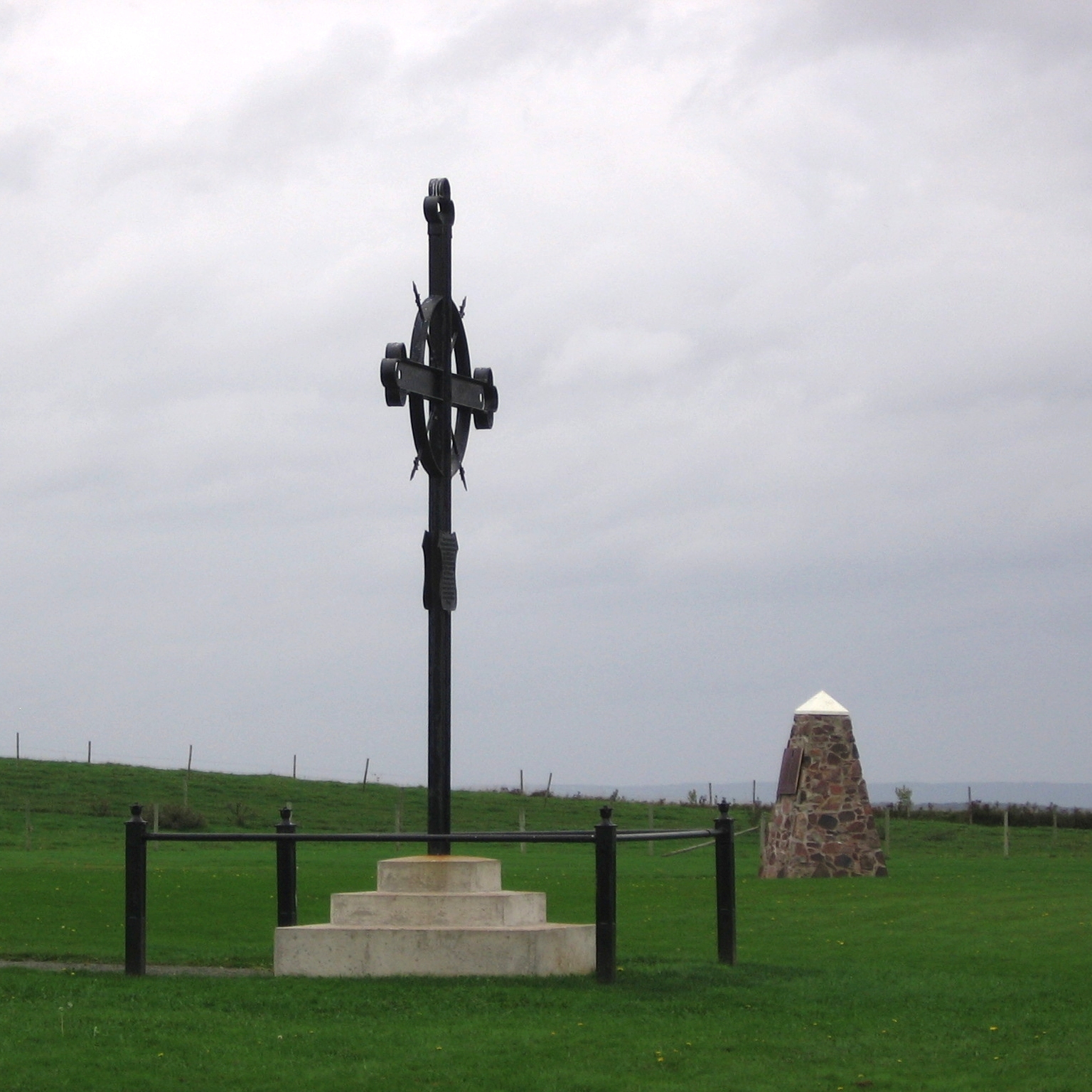|
Steam Mill Village
Steam Mill Village is a rural community north of Kentville, Nova Scotia, Canada beside Camp Aldershot. It is named after an early steam-powered saw mill. Geography Steam Mill Village is located about 10 km north of Kentville. Route 359, runs through the community. Steam Mill occupies low sandy hills of glacial till marked by stands of oak trees and many large pines. The upper reaches of the Canard River flow through the northern part of Steam Mill Village. History Steam Mill is near the headwaters of the Canard River and was once the head of tide from the river's saltwater estuary. The area was used by early Acadian settlers and later New England Planters at nearby Upper Dyke on the Canard River who used the Steam Mill area in the 18th century as upland pasture. Near the present day crossing of Route 359 over the river, the Acadians built the first of series of dykes across the Canard River, pushing back the salt water tides to create highly productive farmland along the ... [...More Info...] [...Related Items...] OR: [Wikipedia] [Google] [Baidu] |
Nova Scotia
Nova Scotia ( ; ; ) is one of the thirteen provinces and territories of Canada. It is one of the three Maritime provinces and one of the four Atlantic provinces. Nova Scotia is Latin for "New Scotland". Most of the population are native English-speakers, and the province's population is 969,383 according to the 2021 Census. It is the most populous of Canada's Atlantic provinces. It is the country's second-most densely populated province and second-smallest province by area, both after Prince Edward Island. Its area of includes Cape Breton Island and 3,800 other coastal islands. The Nova Scotia peninsula is connected to the rest of North America by the Isthmus of Chignecto, on which the province's land border with New Brunswick is located. The province borders the Bay of Fundy and Gulf of Maine to the west and the Atlantic Ocean to the south and east, and is separated from Prince Edward Island and the island of Newfoundland (island), Newfoundland by the Northumberland Stra ... [...More Info...] [...Related Items...] OR: [Wikipedia] [Google] [Baidu] |
Rural
In general, a rural area or a countryside is a geographic area that is located outside towns and cities. Typical rural areas have a low population density and small settlements. Agricultural areas and areas with forestry typically are described as rural. Different countries have varying definitions of ''rural'' for statistical and administrative purposes. In rural areas, because of their unique economic and social dynamics, and relationship to land-based industry such as agriculture, forestry and resource extraction, the economics are very different from cities and can be subject to boom and bust cycles and vulnerability to extreme weather or natural disasters, such as droughts. These dynamics alongside larger economic forces encouraging to urbanization have led to significant demographic declines, called rural flight, where economic incentives encourage younger populations to go to cities for education and access to jobs, leaving older, less educated and less wealthy p ... [...More Info...] [...Related Items...] OR: [Wikipedia] [Google] [Baidu] |
Kentville
Kentville is an incorporated town in Nova Scotia. It is the most populous town in the Annapolis Valley. As of 2021, the town's population was 6,630. Its census agglomeration is 26,929. History Kentville owes its location to the Cornwallis River which, downstream from Kentville, becomes a large tidal river at the Minas Basin. The riverbank at the current location of Kentville provided an easy fording point. The Mi'kmaq name for the location was "Penooek". The ford and later the bridge in Kentville made the area an important crossroads for other settlements in the Annapolis Valley. Kentville also marked the limit of navigation of sailing ships. Acadian settlement The area was first settled by Acadians, who built many dykes along the river to keep the high Bay of Fundy tides out of their farmland. These dykes created the ideal fertile soil that the Annapolis Valley is known for. The Acadians were expelled from the area in the Bay of Fundy Campaign (1755) by the British authoritie ... [...More Info...] [...Related Items...] OR: [Wikipedia] [Google] [Baidu] |
Canada
Canada is a country in North America. Its ten provinces and three territories extend from the Atlantic Ocean to the Pacific Ocean and northward into the Arctic Ocean, covering over , making it the world's second-largest country by total area. Its southern and western border with the United States, stretching , is the world's longest binational land border. Canada's capital is Ottawa, and its three largest metropolitan areas are Toronto, Montreal, and Vancouver. Indigenous peoples have continuously inhabited what is now Canada for thousands of years. Beginning in the 16th century, British and French expeditions explored and later settled along the Atlantic coast. As a consequence of various armed conflicts, France ceded nearly all of its colonies in North America in 1763. In 1867, with the union of three British North American colonies through Confederation, Canada was formed as a federal dominion of four provinces. This began an accretion of provinces and ... [...More Info...] [...Related Items...] OR: [Wikipedia] [Google] [Baidu] |
Camp Aldershot
5th Canadian Division Support Group Detachment Aldershot (also 5 CDSG Det Aldershot) is a training facility for 5th Canadian Division of the Canadian Army. It is located in Kings County, Nova Scotia. 5 Cdn Div Support Group Det Aldershot is located northwest of Kentville on a well-drained sandy plateau along the north side of the Cornwallis River. Surrounded by the agricultural heartland of Nova Scotia in the Annapolis Valley, 5 Cdn Div Support Group Detachment Aldershot is situated primarily on marginal agricultural land not suitable for crop growing. Relatively few military personnel are stationed at the camp as it serves primarily for training regular force and Primary Reserve units of the Canadian Army's 5th Canadian Division. 5th Canadian Division Training Centre conducts year-round courses for Regular Force and Primary Reserve personnel, while expanding dramatically during the summer months to accommodate the numerous courses for Primary Reserve personnel and some Regular F ... [...More Info...] [...Related Items...] OR: [Wikipedia] [Google] [Baidu] |
Nova Scotia Route 359
Route 359 is a collector road in the Canadian province of Nova Scotia. It is located in Kings County and connects Kentville near Trunk 1 with Halls Harbour. Communities *Kentville *Aldershot * Steam Mill Village * Centreville *East Halls Harbour Road * Halls Harbour See also *List of Nova Scotia provincial highways This is a list of numbered highways in the province of Nova Scotia. Arterial (100-series) highways A 100-series highway is a designation applied to a highway that can be a controlled-access expressway, Super-2, or fully divided freeway. The ... References Nova Scotia provincial highways Roads in Kings County, Nova Scotia {{NovaScotia-road-stub ... [...More Info...] [...Related Items...] OR: [Wikipedia] [Google] [Baidu] |
Glacial Till
image:Geschiebemergel.JPG, Closeup of glacial till. Note that the larger grains (pebbles and gravel) in the till are completely surrounded by the matrix of finer material (silt and sand), and this characteristic, known as ''matrix support'', is diagnostic of till. image:Glacial till exposed in roadcut-750px.jpg, Glacial till with tufts of grass Till or glacial till is unsorted glacier, glacial sediment. Till is derived from the erosion and entrainment of material by the moving ice of a glacier. It is deposited some distance down-ice to form terminal, lateral, medial and ground moraines. Till is classified into primary deposits, laid down directly by glaciers, and secondary deposits, reworked by fluvial transport and other processes. Description Till is a form of '' glacial drift'', which is rock material transported by a glacier and deposited directly from the ice or from running water emerging from the ice. It is distinguished from other forms of drift in that it is dep ... [...More Info...] [...Related Items...] OR: [Wikipedia] [Google] [Baidu] |
Canard River
The Canard River is a river in Kings County, Nova Scotia, Canada which drains into the Minas Basin of the Bay of Fundy between the communities of Canard and Starr's Point. It is known for its fertile river banks and extensive dyke land agriculture. Geography The river has its source in a number of small brooks which flow from the sandy pine woods of what is now the Camp Aldershot military base, near Steam Mill Village. The Canard River has a short length of 15 km but its lower reaches are wide and deep due to the enormous tides of the Minas Basin. The river was once tidal for most of its length but a series of dykes first built in the 1600s held back the tide which is now stopped near the river's mouth by the Wellington Dyke. The upper reaches of the river are often referred to by the dykes which once spanned the river - Upper Dyke and Middle Dyke. History The Canard river was known to the Mi'kmaq people as Apocheechumochwakade meaning "home of the black duck". The Mi'km ... [...More Info...] [...Related Items...] OR: [Wikipedia] [Google] [Baidu] |
Acadians
The Acadians (french: Acadiens , ) are an ethnic group descended from the French who settled in the New France colony of Acadia during the 17th and 18th centuries. Most Acadians live in the region of Acadia, as it is the region where the descendants of a few Acadians who escaped the Expulsion of the Acadians (aka The Great Upheaval / ''Le Grand Dérangement'') re-settled. Most Acadians in Canada continue to live in majority French-speaking communities, notably those in New Brunswick where Acadians and Francophones are granted autonomy in areas such as education and health. Acadia was one of the 5 regions of New France. Acadia was located in what is now Eastern Canada's Maritime provinces, as well as parts of Quebec and present-day Maine to the Kennebec River. It was ethnically, geographically and administratively different from the other French colonies and the French colony of Canada (modern-day Quebec). As a result, the Acadians developed a distinct history and cultu ... [...More Info...] [...Related Items...] OR: [Wikipedia] [Google] [Baidu] |
New England Planters
The New England Planters were settlers from the New England colonies who responded to invitations by the lieutenant governor (and subsequently governor) of Nova Scotia, Charles Lawrence, to settle lands left vacant by the Bay of Fundy Campaign (1755) of the Acadian Expulsion. History Eight thousand Planters (roughly 2000 families), largely farmers and fishermen, arrived from 1759 to 1768 to take up the offer. The farmers settled mainly on the rich farmland of the Annapolis Valley and in the southern counties of what is now New Brunswick but was then part of Nova Scotia. Most of the fishermen went to the South Shore of Nova Scotia, where they got the same amount of land as the farmers. Many fishermen wanted to move there, especially since they were already fishing off the Nova Scotia coast. The movement of some 2000 families from New England to Nova Scotia in the early 1760s was a small part of the much larger migration of the estimated 66,000 who moved to New York's M ... [...More Info...] [...Related Items...] OR: [Wikipedia] [Google] [Baidu] |
Saw Mills
A sawmill (saw mill, saw-mill) or lumber mill is a facility where logs are cut into lumber. Modern sawmills use a motorized saw to cut logs lengthwise to make long pieces, and crosswise to length depending on standard or custom sizes (dimensional lumber). The "portable" sawmill is of simple operation. The log lies flat on a steel bed, and the motorized saw cuts the log horizontally along the length of the bed, by the operator manually pushing the saw. The most basic kind of sawmill consists of a chainsaw and a customized jig ("Alaskan sawmill"), with similar horizontal operation. Before the invention of the sawmill, boards were made in various manual ways, either rived (split) and planed, hewn, or more often hand sawn by two men with a whipsaw, one above and another in a saw pit below. The earliest known mechanical mill is the Hierapolis sawmill, a Roman water-powered stone mill at Hierapolis, Asia Minor dating back to the 3rd century AD. Other water-powered mills followed ... [...More Info...] [...Related Items...] OR: [Wikipedia] [Google] [Baidu] |
Cornwallis Valley Railway
The Cornwallis Valley Railway (CVR) was a historic Canadian railway in Nova Scotia's Annapolis Valley. It was built in 1889 and ran from Kentville to Kingsport serving the Cornwallis Township area of Kings County. For most of its history, it operated as a branch line of the Dominion Atlantic Railway and was sometimes known as the "Kingsport Line". Route The CVR crossed its namesake, the Cornwallis River, at Kentville and ran north to stations at the Camp Aldershot military base, Mill Village (Steam Mill), and Centreville and then ran east to Ford's Crossing (Gibson Woods), Sheffield Mills, Hillaton, Canning, Pereau, and ended on the large government wharf at Kingsport. An additional branch, the North Mountain Line was added in 1914 running from Centreville to Weston. Creation The Cornwallis Valley Railway was formed in 1887 by merchants in Canning, Nova Scotia, and Kentville including the Member of Parliament Frederick William Borden. Canning merchant Stephen ... [...More Info...] [...Related Items...] OR: [Wikipedia] [Google] [Baidu] |





